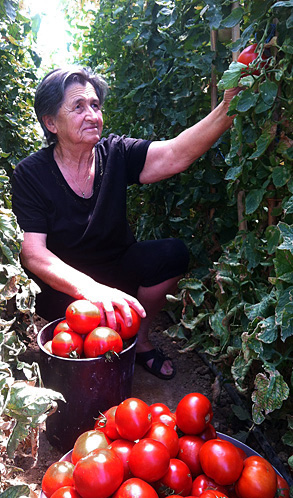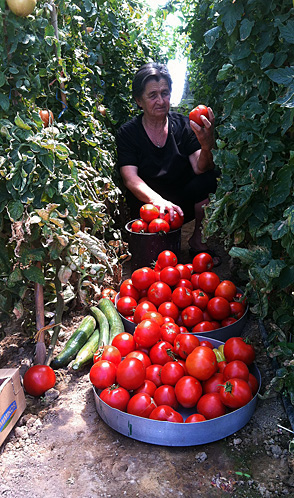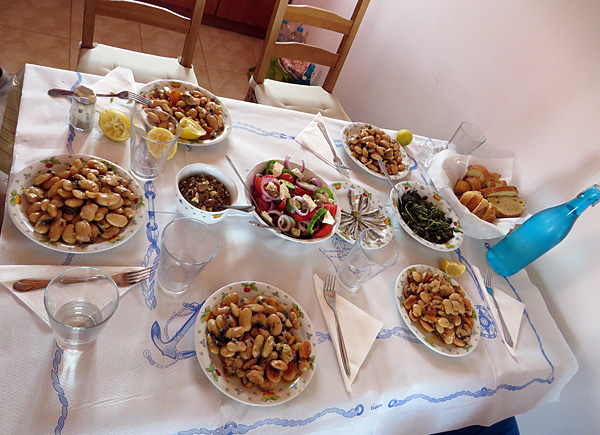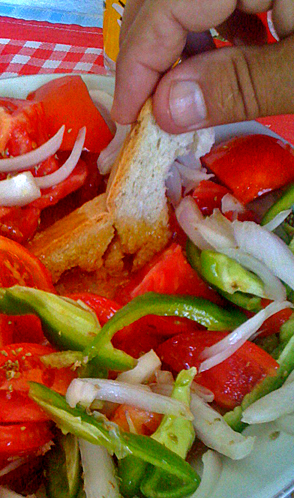No need to say that the Greek Salad (horiatiki) is known and loved worldwide, “Horiatiki” (Χωριάτικη) means “from the village” in Greek and all the ingredients used to make the salad are things that every agricultural family grows or has immediate access to. Traditionally made in the Greek villages with local, seasonal products during the summer months, it is nowadays enjoyed everywhere all year round.
Its popularity in the recent years is due to the fact that is simply so tasty, nutritious and healthy. It perfectly represents the Mediterranean diet praised worldwide for contributing to good health, longer lifespan and better quality of life. Nevertheless, as Felicity Cloake correctly points out “it’s pretty rare to get one outside Greece that really knocks your socks off. Anyone can make an OK Greek salad, but how do you do this classic justice?”

How to make the perfect Greek salad Made in Britain
Who could better answer the question than a Greek living abroad?
Let me start by saying that I will reveal the secret ingredient that no one can get right: the place. What do I mean? Nothing can compare to the aromatic, juicy fruits and vegetables growing in Greece. The rich land infuses everything growing on it with the strongest aromas, sweetest tastes and vibrant colours. You might as well have enjoyed a horiatiki by the sea with the soft, salty summer breeze caressing the cheeks. Isn’t this part of what makes everyone remember the salad they tasted back in Greece with sweet melancholy?
Having that said, there is still hope for the rest of us wanting the original taste but don’t live in Greece.
Greek Salad Ingredients
The ingredients are very standard. You can add or replace according to personal preferences, which is fine. Any addition, though, would make my grandma, frown upon with disapproval; and my grandma’s approval is very important!
I find it quite entertaining when well-known chefs are trying to add their personal touch. The worst, by far, is the addition of lettuce. Whyyyyy? You’ve got all these nice crunchy pieces and then you’ve got the lettuce leaves which feel like they stealthily made their way in, desperately trying to get part of the fame. No, no lettuce please.


My grandma Athanasia treats her tomato vines with special care and in return she gets the most delicious fruits!
Tomato
They have to be ripe and juicy. Use large tomatoes with strong aroma; consult your nose to pick the right ones for your salad (yes, smell them). Traditionally, the tomato is cut in rather large pieces over the serving bowl so that no part if its juice goes wasted.
Cucumber
Chilled, crunchy cucumber. Some peel the skin some others not. The ideal size comes from cutting the whole cucumber in half before slicing it.
Pepper
Use green pepper in thin slices. Not red, orange, yellow or any of the other colours of the rainbow; just green. Not everyone’s preference, though, especially if you are not used to it so some just omit it.
Onion
Red onion cut in rings. For practical reasons (some of the rings’ diameter is just too large to fit neatly into the mouth) the rings can be cut in half. Some, my grandma included, soak the onion in water to soften down the intensity and eliminate the dragon breath effect.
Olives
Brown, Kalamata olives which you can find in almost every large super market. Almost any kind of Greek olives I would say especially if they are locally produced. Since I am mainly talking about the UK, though, I would say only trust Kalamata olives. The black, tasteless olives having tasted in many UK restaurants and pubs are just sad.
Feta cheese
The original feta cheese is made out of sheeps’ milk and cannot stress enough that “white cheese” or “Greece style cheese” or “salad cheese” types are as far as they could be from the original feta. There are many varieties covering all taste buds. I have to admit there are a couple very decent ones in the big UK super markets but have been left quite disappointed by their own brands.
Feta is placed last, cut in one large piece. You can “sacrifice” aesthetics for practicality by crumbling it in pieces.
Salt
Sea salt please and definitely not coarse.
Oregano
If it’s not from the Greek mountains it’s not worth it; seriously. There is no way you will ever be able to buy oregano as strong and aromatic as the wild one. If visiting Greece is not in your immediate plans (and why is that?) you can look for mountain wild oregano in specialised shops.
Extra Virgin Olive Oil
Use only Extra Virgin Olive Oil in generous quantities. I have noticed a fear of the Brits towards anything that has to do with fat. It is a subject I am not going to tackle now, but I will just mention that olive oil is essential to help the body absorb the vegetables’ nutrients.
Vinegar
It has to be red wine vinegar and used in much smaller quantities than the olive oil.

Horiaki salad is part of almost every Greek meal during the summer.
Quantities & Putting it Together
There are no specific quantities as “the eye” and personal preference is the measurement; at least traditionally. Some add more tomatoes while some others prefer more cucumbers. In any case, horiatiki is a salad you don’t want to stir especially after the feta cheese has been added.You don’t want to keep it out long after you’ve made it either as it will lose its freshness.
How to eat the Greek Salad | Papara

Greeks can tell a foreigner eating a horiatiki from miles away. The salad is eaten neatly; one piece at a time and….and the juice at the bottom of the bowl is just left intact! All the heart of the specific salad is there! The bottom of the plate is where the best part hides. So, we use bread to get to it and have awarded a special name to the specific action called “Papara”.
How to do the papara: Cut with your hands a small piece of bread, make an opening on one side of the salad bowl, let the piece soak up some of the juice and eat (no fork involved). Oh joy! Now you are hooked.
Appetiser or Main Meal?
Every Greek meal includes at least one type of salad and all the dishes are served and eaten at the same time. In tavernas (restaurants serving traditional food) they usually ask whether the salad should be served first or with the main meal and, as usually hunger takes over, many times the salad is eaten first while the other courses are prepared. As a horiatiki is quite filling and nutritious it can easily be the main meal of the day especially for those following a healthy diet.
Final Note: For those worrying about the onion smell, I have the solution my friends; wash it down with tsipouro. What is tripouro? Oh well, this is a whole new topic.
Enjoy!!
